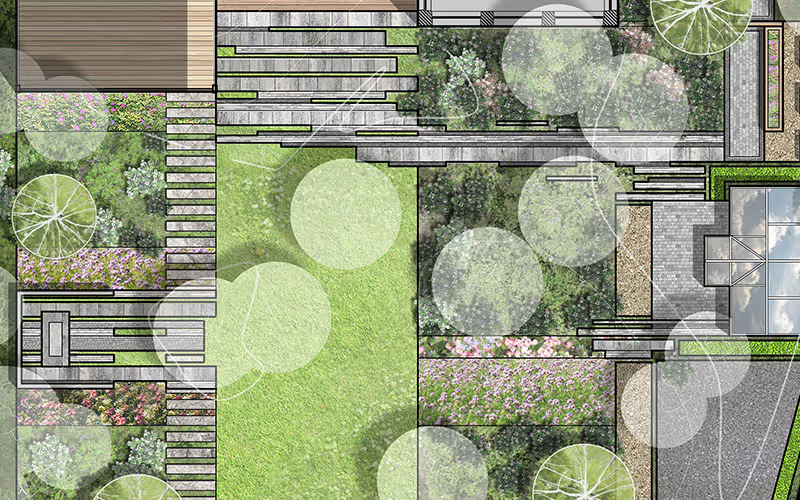A good landscape plan is the ultimate communication tool for designers, contractors, property managers and current or future clients/tenants.
Depending on the phase of a project, a good plan can be valuable in many ways, including illustrating the future project's vision, communicating to a contractor what to build, where and aiding in the decision-making process when refreshing built projects.
I will highlight in this article how important the humble landscape plan is in the creation of people-first places.
What is a landscape plan?
A landscape plan can present an infinite combination of information - depending on the drawing's intention, purpose and scale. As you've probably guessed, plans are in plan view [overhead]. Like a map, a landscape plan will have a scale bar, north arrow and legend in some form.
Types of landscape plans
Designers use plans in different forms at every stage of planning, design and construction. It is such an ingrained method of thinking about projects that it took me a moment to distance myself from the process and realize how prevalent plans are in the workday.
I organized just some of the many landscape plans we use in order of appearance in a typical project below.
1. Site analysis plans
First things first—what is going on with the existing site? Landscape architects do a deep dive into the site's current and historical conditions before even thinking about their designs.
A site analysis can also include: infrastructure, legal boundaries, built form, climactic conditions, and even cultural significance. We then synthesize all this information into landscape plans and reports that assist in the future phases of design.
2. Concept plans
Using the information retrieved from the site analysis, designers can start to conceptualize a design on the site. Drawing in plan view is very helpful when understanding relationships between programs, infrastructural and existing natural elements.
Concept images and plans, as the name suggests, convey the intent and feel of the design. These plans range from hand-drawn on a napkin to fully rendered presentation-quality images.
3. Bubble Plan
A bubble plan is a diagram of lines and circles that show the functional relationship between different areas in a landscape plan. Such plans are “probably the most versatile and basic device for abstraction.”
Depending on the designer's work method or the project deliverables, a bubble plan can work with or before the concept plan. Like the sketches in a designers sketchbook, bubble plans remain largely unpublicized, but that doesn’t mean they are not an integral part of the design process.
4. Design site plan
A site plan is an overview that displays the proposed design scaled on the property. A landscape site plan would typically include the landscape design and any existing or proposed buildings and infrastructure within or directly adjacent to the property boundaries.
Architects or engineers can use these plans to coordinate conversations with clients and permit applications.
5. Planting plan
Each flower, shrub and sometimes tree is typically omitted graphically from the overall site plan for clarity. So, we create a separate plan or series of plans to illustrate what plant species, locations and quantities require placement in the project.
Why do you need a landscape plan?
A well-organized plan is necessary for effective collaboration, meeting timelines and just the success of any project (not just in design). Similarly, a well-organized and thoughtful landscape plan is essential for every stage of your design project. I have outlined the importance of a plan in each phase of a project below.
A. Future Projects
Before you can build something, there is always someone you must convince. Be it the client, the city or the public. Concept plans rendered to be photorealistic or another graphic style that portrays the future character of the project can be an excellent tool for designers to communicate their intentions.
Concept plans should transcend the understanding of the clients, shareholders and general public. In other words, people who are not in the design or construction industry. These plans typically find use before the project breaks ground. Still, some significant developments can take many years to complete, so it is essential to continually share the completed vision with the public as they wait for the finished project.
B. Present Projects (Under Construction)
Construction plans and drawings are black and white technical drawings of what and where to construct the design. The general public won't necessarily understand these plans because they reflect a communication tool used between professional designers and skilled contractors.
Construction plans range in scale from broad overviews of the entire project to a close-up view of the tiniest details. A well-done set of landscape construction drawings can reduce oversights and, in turn, prevent cost overruns.
C. Past Projects (Renovation)
Even after the presentation and construction phases, it is still valuable to have a working landscape plan for any future changes to the site. Any changes should reference the overall plan. Elements such as circulation routes, sightlines, shadow studies, mature tree canopy projections, drainage patterns, etc., are all necessary when deciding on changes within the plan's illustration.
To Sum Up
Landscape plans are a critical tool for everyone involved in the urban design process, from the clients to the contractors to the public. Hopefully, we have inspired you to have a little more appreciation for the landscape plan.


